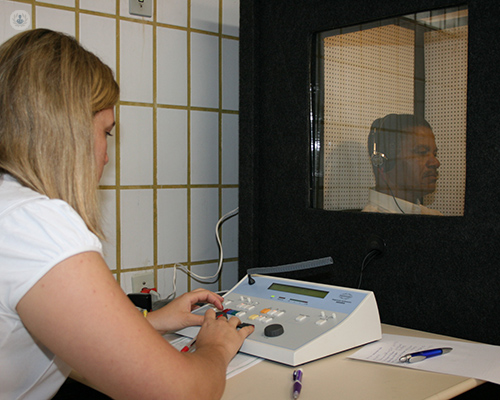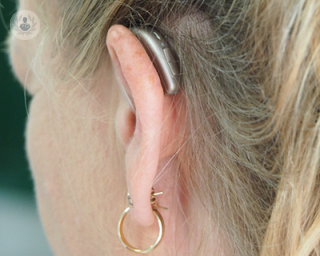Audiometry
Mr Mriganka De - Otolaryngology / ENT
Created on: 11-13-2012
Updated on: 04-24-2024
Edited by: Karolyn Judge
What is audiometry?
An audiometry exam evaluates your hearing function in terms of tone, balance and sound intensity. It focuses on the functioning of the inner ear. The human ear can perceive sounds with tones that range between 20 and 20,000 Hertz. The human ear can hear sounds with intensity ranging from 20 decibels upwards.

What does audiometry involve?
An audiometry exam involves several different tests. A pure tone audiometry test measures softest, quietest sounds you can hear at different pitches. This uses an audiometer which is a special machine that plays sounds via headphones. You will indicate to the clinician which sounds you can hear.
A speech audiometry exam tests how well you can hear speech at different tones.
The exam is divided into tonal and verbal audiometry. In tonal audiometry, the airway and the bony route are evaluated, which in both cases involves the exploration of the two ears separately, with the patient inside a soundproof and hermetically sealed cabin. In air audiometry, the individual must put on headphones and then the specialist plays a series of sounds from higher to lower volume until they are inaudible. The last perceived sound determines the auditory threshold, that is, to what intensity the patient can hear at a certain frequency. In the inspection of the bone path, a vibrator is placed behind the patient's ear, in the mastoid, where it receives the sound.
Verbal audiometry is also performed with the patient in a booth and with headphones, but instead of sound, words are issued at different volumes that must be repeated exactly. A word-recognition test is also performed which measures the patient’s ability to discriminate between speech and background noise.
Tympanometry testing can uncover any problems with wax or fluid build-up, eardrum damage, ossicle bone damage or tumours in the middle ear.
An acoustic reflex test is used to locate where the hearing impairment may be located.
Why is audiometry done?
Audiometry can detect hearing loss and is performed when a patient has trouble hearing or as part of a routine screening. An audiometry exam can determine whether someone is suffering from sensorineural hearing loss (nerve or cochlea damage) or conductive hearing loss (ear drum or ossicle bone damage).
Hearing loss commonly results from:
- Chronic ear infections
- Congenital malformations;
- Damage to the eardrum or inner ear;
- Exposure to loud noises on a regular basis;
- Inner ear diseases;
- Inherited conditions.
How to prepare for an audiometry test
No special preparation is needed for an audiometry test.
How does it feel during the audiometry exam?
During an audiometry test, the patient does not feel any discomfort. The duration of the audiometry exam varies depending on whether it is an initial evaluation, which can last between five to 10 minutes; or if it is a detailed evaluation that can last up to almost an hour.
Are there any risks involved in an audiometry exam?
Audiometry is non-invasive and carries no risks.
What do abnormal results from an audiometry test mean?
Audiometry test results are shown on a graph (audiogram). The results are reviewed by an ENT or audiovestibular specialist and if they confirm hearing loss, management and treatment techniques will be discussed. These could include wearing a hearing aid.












